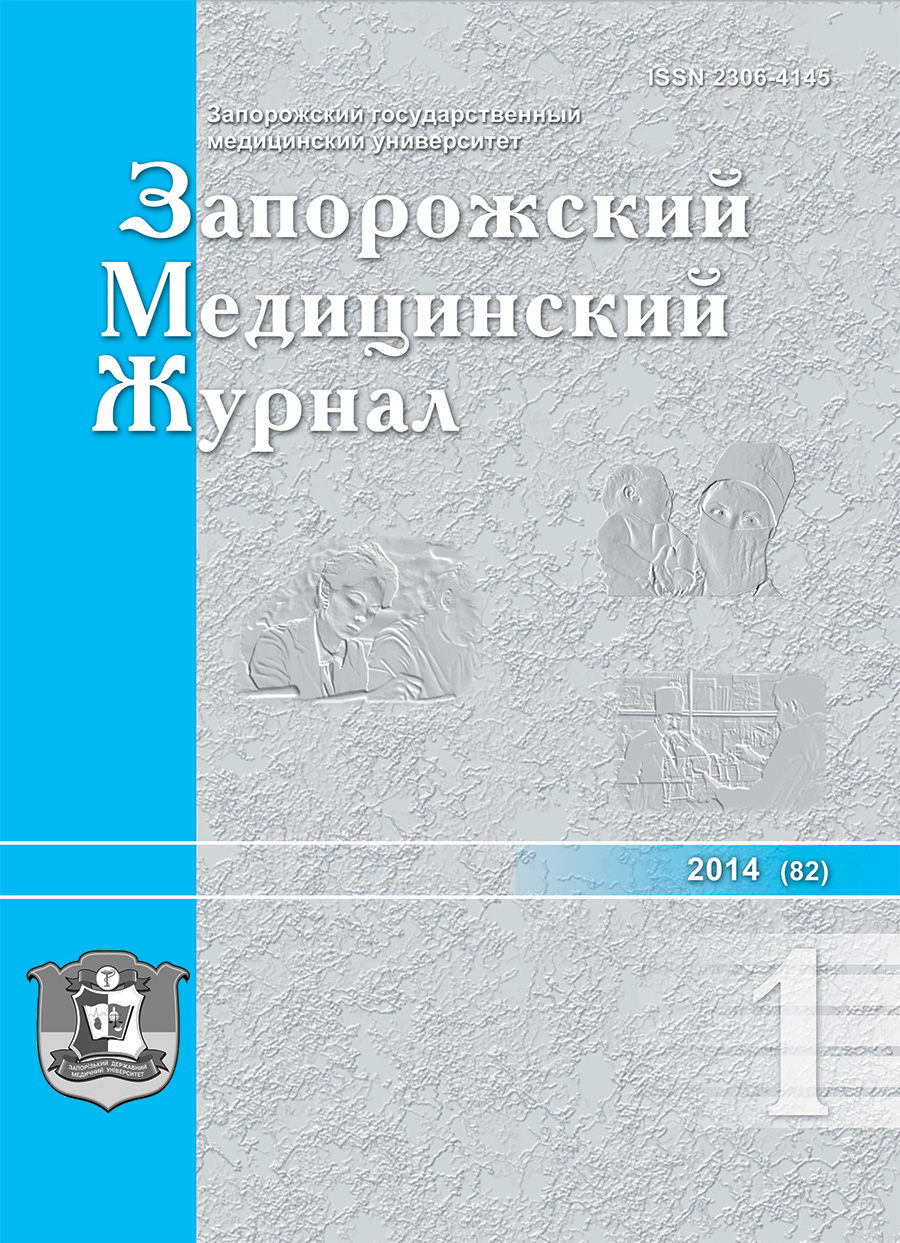MEDICAL AND PSYCHOLOGICAL CORRECTION AND REHABILITATION OF PREGNANT WOMEN WITH SOMATOFORM DYSFUNCTION OF VEGETATIVE NERVOUS SYSTEM
DOI:
https://doi.org/10.14739/2310-1210.2014.1.23703Keywords:
complications of pregnancy, somatoform vegetative dysfunction, neurocirculatory dystonia, psycho-emotional state, medical and psychological correctionAbstract
Introduction Neurocirculatory dystonia (NCD) takes one of the leading positions among different extragenital diseases in pregnant women, and it promotes complications of pregnancy, labor and postpartum period.
NCD which is included into the diagnostic section “Somatoform vegetative dysfunction” – is polyetiologic functional disease of cardiovascular system based on disorders of neuroendocrine regulation with multiple and various clinical signs that become worse in stress influence.
Object of the work – is to estimate influence of medical and psychological correction program on the psycho-emotional state and rate of gestation complications in pregnant women with somatoform dysfunction of vegetative nervous system (SDVNS).
Materials and methods of investigations There 56 pregnant women with NCD and it is the evidence of somatoform dysfunction of vegetative nervous system within gestation period of 12-34 weeks were examined in the study. Presence of this extragenital pathology was clinically proved by therapeutist. I group included 29 pregnant women who participated in the complex program of medical and psychological correction and sanatorium rehabilitation. II group included 27 pregnant women having rehabilitation in accord with standards of sanatorium-resort therapy. Control group comprised 24 somatically healthy pregnant women. Level of trait and state anxiety were estimated under methods of Spielberg-Hanin. Estimation of type of attitude towards the disease and of other associated personal attitudes was carried out using Personality Questionnaire of the V.M. Bekhterev Institute (PQBI).
Results and their discussion. High rate of combination of SDVNS with various somatic pathology both in group I and group II was found (86.2% and 85.2% correspondingly). By comparing the results before sanatorium health improvement it was defined that average and high levels of state anxiety were dominating in all groups (group І - 91.7%, group II – 85% and 87.5% – in control group).
After complex program of medical and psychological correction and sanatorium rehabilitation the estimation of psychological status of the pregnant women of group I showed the reduced level of anxiety in 79% of women. During analysis of labor progress it was found that the distress rate in group I and control group were 3.5 % and 4.2 % correspondingly. In addition the attention was paid to the high rate of fetus distress and weak labor process of women in group II (14.8% each correspondently). These complications increase the rate of operative delivery in group II which was two times higher in comparison with group I.
Conclusions
It was showed rather high level of trait and state anxiety of the pregnant women with SDVNS than in somatically healthy women. Program of medical and psychological correction of psycho-emotional state and sanatorium rehabilitation of the pregnant women with SDVNS helps to reduce level of state anxiety and in such way it influences on the indicators of obstetrics, reducing the rate of abnormalities of labor process and fetus distress during labor.
References
Астахов В.М. Методы психодиагностики индивидуально-психологических особенностей женщин в акушерско-гинекологической клинике / В.М. Астахов, И.В. Быцылева, И.В. Пузь; [под ред. В.М. Астахова]. – Донецк: Норд-Пресс, 2010. – 199 с.
Біловол О.М. Основи діагностики, лікування і профілактики основних кардіологічних захворювань: навч. посіб. для студ. V курсу мед. ВНЗ IV рівня акредит.: у 2 ч. / [О.М. Біловол, П.Г. Кравчун, М.І. Кожин та ін.]; за ред. О.М. Біловола і П.Г. Кравчуна. – Харків: ХНМУ, 2009. – Ч. 2. – 400 с.
Коваленко В.М. Серцево-судинні захворювання. Класифікація, стандарти діагностики та лікування кардіологічних хворих / [за ред. проф. В.М. Коваленка, проф. М.І. Лутая, проф. Ю.М. Сіренка]. – К.: Бізнес Поліграф, 2007. – 128 c.
Лобода М.В. Стандарти (клінічні протоколи) санаторно-курортного лікування / [за заг. ред. М.В. Лободи, К.Д. Бабова, Т.А. Золотарьової, Л.Я. Гріняєвої]. – К.: КІМ, 2008. – 384 с.
Медведь В.И. Введение в клинику экстрагенитальной патологии беременных / В.И. Медведь. – К.: Авиценна, 2004. – 168 с.
Медведь В.И. Экстрагенитальная патология беременных: материнские и перинатальные проблемы / В.И. Медведь // Жіночий лікар. – 2010. – № 4. – C. 5–10.
Медведь В.И. Профилактика осложнений беременности при экстрагенитальной патологии – важнейшая задача женской консультации (обзор литературы) / [В.И. Медведь, Т.В. Авраменко, О.Е. Данылкив, В.Е. Исламова] // Вісник Харківського національного університету імені В.Н. Каразіна (Медицина). – 2006. – Вип. 12. – С. 145–151.
Международная классификация болезней (10-й пересмотр) Классификация психических и поведенческих расстройств / [пер. с англ. Ю.Л. Нуллер, С.Ю. Циркин]. – К.: Сфера, 2005. – 306 с.
Менделевич В.Д. Клиническая и медицинская психология: учебное пособие / В.Д. Менделевич. – М.: МЕДпресс-информ, 2008 . – 432 с.
Медведев В.Э. Нейроциркуляторная дистония (кардионевроз): междисциплинарный подход к диагностике и терапии / В.Э. Медведев // АтмосферА. Нервные болезни. – 2010. – № 3. – С. 2–6.
Польський В.В. Функціональні захворювання серцево-судинної системи і вагітність: монографія / В.В. Польський. – К.: Експерт, 2005. – 248 с.
Швец Н.И. Нейроциркуляторная дистония: диагностика и лечение (лекция) / Н.И. Швец, Т.М. Бенца, Л.А. Дидух // Сімейна медицина. – 2009. – № 1. – С. 23–28.
Downloads
How to Cite
Issue
Section
License
Authors who publish with this journal agree to the following terms:
Authors retain copyright and grant the journal right of first publication with the work simultaneously licensed under a Creative Commons Attribution License that allows others to share the work with an acknowledgement of the work's authorship and initial publication in this journal. 

